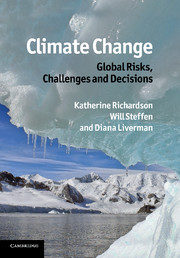Book contents
- Frontmatter
- Contents
- Writing team
- Foreword
- Preface
- List of acronyms and abbreviations
- Part I Climatic trends
- Part II Defining ‘dangerous climate change’
- Part III Equity issues
- Part IV Mitigation and adaptation approaches
- Part V Meeting the challenge
- 15 Integrating adaptation, mitigation and sustainable development
- 16 Mobilising the population
- 17 The human–Earth relationship: past, present and future
- Index
- Plate section
- References
15 - Integrating adaptation, mitigation and sustainable development
Published online by Cambridge University Press: 04 April 2011
- Frontmatter
- Contents
- Writing team
- Foreword
- Preface
- List of acronyms and abbreviations
- Part I Climatic trends
- Part II Defining ‘dangerous climate change’
- Part III Equity issues
- Part IV Mitigation and adaptation approaches
- Part V Meeting the challenge
- 15 Integrating adaptation, mitigation and sustainable development
- 16 Mobilising the population
- 17 The human–Earth relationship: past, present and future
- Index
- Plate section
- References
Summary
‘Forget about making poverty history. Climate change will make poverty permanent’
Climate change and sustainable development are urgent problems that are closely related and, therefore, can be most effectively addressed in an integrated fashion. The challenge of sustainable development must confront the unmet development goals of many poorer nations, and this creates additional tensions in north–south negotiations about climate change (Box 13.1). Climate change is one indicator that contemporary society is currently on an unsustainable pathway, and so climate change can be viewed as one component of the broader challenge of achieving global sustainability. In fact, climate change impacts are perhaps most appropriately framed not as isolated phenomena but, rather, as potent threat multipliers that will exacerbate the multiple problems we already face – such as poverty, hunger, illness, water and energy scarcities, environmental degradation, and conflict. Conversely, unsustainable development patterns will not only increase greenhouse gas emissions that worsen climate change, but also increase vulnerability to the impacts of climate change.
The need to address climate risks, climate response and development has been recognised by major international institutions as well as a growing number of NGOs and national development agencies. The international development community has started to confront the challenge of integrating adaptation, mitigation and development through several major reports on climate and development, and a debate about ‘mainstreaming’ climate into development policies.
- Type
- Chapter
- Information
- Climate Change: Global Risks, Challenges and Decisions , pp. 415 - 450Publisher: Cambridge University PressPrint publication year: 2011



